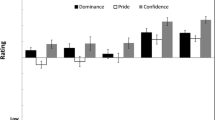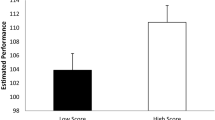Abstract
The goal of the paper was to test if humans can detect whether athletes are trailing or leading in sports based on the perception of thin slices of athletes’ nonverbal behavior. In Experiment 1, participants who were unexperienced in the respective sports watched short videos depicting basketball and table tennis players and rated whether athletes were trailing or leading. Results indicated that participants could significantly differentiate between trailing and leading athletes in both team and individual sports. Experiment 2 showed that children were also able to distinguish between trailing and leading athletes based on nonverbal behavior. Comparison with the adult results from Experiment 1 revealed that the adult ratings corresponded to a higher degree with the actual scores during the game compared to the children’s. In Experiment 3, we replicated the findings from Experiment 1 with both expert and unexperienced participants and a different set of stimuli from team handball. Both experts and unexpert participants were able to differentiate between leading and trailing athletes. Our findings are in line with evolutionary accounts of nonverbal behavior and suggest that humans display nonverbal signals as a consequence of leading or trailing which are reliably interpreted by others. By comparing this effect as a function of different age groups we provide evidence that although even young children can differentiate between leading and trailing athletes, the decoding of subtle nonverbal cues continues to develop with increasing experience and maturation processes.




Similar content being viewed by others
Notes
In order to maximize transparency in the conducted research we provide hyperlinks to the stimulus material utilized in the studies. Note that the software randomly selected and displayed the stimulus material from the video stream according to the described procedure and not as shown in the video streams: basketball: (http://www.youtube.com/watch?edit=vd&v=UsviKNsOkUM), table tennis: (http://www.youtube.com/watch?v=2Y3YeYqTnSY), handball: (http://www.youtube.com/watch?v=w4zuaDe9dzs).
References
Ambady, N., Bernieri, F. J., & Richeson, J. A. (2000). Toward a histology of social behavior: Judgmental accuracy from thin slices of the behavioral stream. In M. P. Zanna (Ed.), Advances in experimental social psychology (Vol. 32, pp. 201–271). San Diego, CA: Academic Press.
Ambady, N., & Gray, H. M. (2002). On being sad and mistaken: Mood effects on the accuracy of thin-slice judgments. Journal of Personality and Social Psychology, 83, 947–961. doi:10.1037//0022-3514.83.4.947.
Ambady, N., Krabbenhoft, M. A., & Hogan, D. (2006). The 30-sec sale: Using thin-slice judgments to evaluate sales effectiveness. Journal of Consumer Psychology, 16, 4–13. doi:10.1207/s15327663jcp1601_2.
Ambady, N., & Rosenthal, R. (1992). Thin slices of expressive behavior as predictors of interpersonal consequences: A meta-analysis. Psychological Bulletin, 111, 236–274. doi:10.1037//0033-2909.111.2.256.
Archer, J. (2006). Testosterone and human aggression: An evaluation of the challenge hypothesis. Neuroscience and Biobehavioral Reviews, 30, 319–345. doi:10.1016/j.neubiorev.2004.12.007.
Balas, B., Kanwisher, N., & Saxe, R. (2012). Thin-slice perception develops slowly. Journal of Experimental Child Psychology, 112, 257–264. doi:10.1016/j.jecp.2012.01.002.
Batty, M., & Taylor, M. J. (2006). The development of emotional face processing during childhood. Developmental Science, 9, 207–220. doi:10.1111/j.1467-7687.2006.00480.x.
Booth, A., Shelley, G., Mazur, A., Tharp, G., & Kittok, R. (1989). Testosterone and winning and losing in human competition. Hormones and Behavior, 23, 556–571. doi:10.1016/0018-506X(89)90042-1.
Borkenau, P., Mauer, N., Riemann, R., Spinath, F. M., & Angleitner, A. (2004). Thin slices of behavior as cues of personality and intelligence. Journal of Personality and Social Psychology, 86, 599–614. doi:10.1037/0022-3514.86.4.599.
Burgoon, J. K. (1996). Nonverbal signals. In M. L. Knapp & G. R. Miller (Eds.), Handbook of interpersonal communication (2nd ed., pp. 344–390). Beverly Hills, CA: Sage.
Carney, D. R., Colvin, C. R., & Hall, J. A. (2007). A thin slice perspective on the accuracy of first impressions. Journal of Research in Personality, 41(5), 1054–1072. doi:10.1016/j.jrp.2007.01.004.
Carney, D., Cuddy, A., & Yap, A. (2010). Power posing: Brief nonverbal displays affect neuroendocrine levels and risk tolerance. Psychological Science, 21, 1363–1368. doi:10.1177/0956797610383437.
Clark-Carter, D. (1997). Doing quantitative psychological research: From design to report. Hove: Psychology Press.
Cohen, J. (1988). Statistical power analysis for the behavioral sciences. Hillsdale, NJ: Erlbaum.
Cumming, G. (2012). Understanding the new statistics: Effect sizes, confidence intervals, and meta-analysis. New York: Routledge.
Curhan, J., & Pentland, A. (2007). Thin slices of negotiation: Predicting outcomes from conversational dynamics within the first five minutes. Journal of Applied Psychology, 92, 802–811. doi:10.1037/0021-9010.92.3.8027.
Darwin, C. (1872). The expression of emotions in man and animals. London: Murray.
de Waal, F. (1998). Chimpanzee politics: Power and sex among apes. Baltimore, MD: Johns Hopkins University Press.
Durand, K., Gallay, M., Seigneuric, A., Robichon, F., & Baudouin, J. Y. (2007). The development of facial emotion recognition: The role of configural information. Journal of Experimental Child Psychology, 97, 14–27. doi:10.1016/j.jecp.2006.12.001.
Ekman, P. (1992). An argument for basic emotions. Cognition and Emotion, 6, 169–200. doi:10.1080/02699939208411068.
Fiedler, K. (2011). Voodoo correlations are everywhere—not only in neuroscience. Perspectives on Psychological Science, 6, 163–171. doi:10.1177/1745691611400237.
Fridlund, A. J. (1994). Human facial expression: An evolutionary view. San Diego, CA: Academic.
Furley, P., & Dicks, M. (2012). “Hold your head high”. The influence of emotional versus neutral nonverbal expressions of dominance and submissiveness in baseball. International Journal of Sport Psychology, 43, 294–311.
Furley, P., Dicks, M., & Memmert, D. (2012a). Nonverbal behavior in soccer: The influence of dominant and submissive body language on the impression formation and expectancy of success of soccer players. Journal of Sport and Exercise Psychology, 34, 61–82.
Furley, P., Dicks, M., Stendtke, F., & Memmert, D. (2012b). “Get it out the way. The wait’s killing me.” Hastening and hiding during soccer penalty kicks. Psychology of Sport and Exercise, 13, 454–465. doi:10.1016/j.psychsport.2012.01.009.
Gao, X., & Maurer, D. (2010). A happy story: Developmental changes in children’s sensitivity to facial expressions of varying intensities. Journal of Experimental Child Psychology, 107, 67–86. doi:10.1016/j.jecp.2010.05.003.
Greenlees, I. A., Bradley, A., Holder, T. P., & Thelwell, R. C. (2005a). The impact of opponents’ non-verbal behaviour on the first impressions and outcome expectations of table-tennis players. Psychology of Sport and Exercise, 6, 103–115. doi:10.1016/j.psychsport.2003.10.002.
Greenlees, I. A., Buscombe, R., Thelwell, R. C., Holder, T. P., & Rimmer, M. (2005b). Impact of opponents’ clothing and body language on impression formation and outcome expectations. Journal of Sport and Exercise Psychology, 27, 39–52.
Kolb, B., Wilson, B., & Taylor, L. (1992). Developmental changes in the recognition and comprehension of facial expression: Implications for frontal lobe function. Brain and Cognition, 20, 74–84. doi:10.1016/0278-2626(92)90062-Q.
Kruglanski, A. W. (1989). The psychology of being “right”. The problem of accuracy in social perception and cognition. Psychological Bulletin, 106, 394–409. doi:10.1037/0033-2909.106.3.395.
Matsumoto, D., & Willingham, B. (2006). The thrill of victory and the agony of defeat: Spontaneous expressions of medal winners at the 2004 Athens Olympic Games. Journal of Personality and Social Psychology, 91, 568–581. doi:10.1037/0022-3514.91.3.568.
Mazur, A., & Booth, A. (1998). Testosterone and dominance in men. Behavioral and Brain Sciences, 21, 353–397. doi:10.1017/S0140525X98001228.
McArthur, L. Z., & Baron, R. M. (1983). Toward an ecological theory of social perception. Psychological Review, 90, 215–238. doi:10.1037//0033-295X.90.3.215.
Mehta, P. H., Jones, A. C., & Josephs, R. A. (2008). The social endocrinology of dominance: Basal testosterone predicts cortisol changes and behavior following victory and defeat. Journal of Personality and Social Psychology, 94, 1078–1093. doi:10.1037/0022-3514.94.6.1078.
Mehta, P. H., & Josephs, R. A. (2010). Testosterone and cortisol jointly regulate dominance: Evidence for a dual-hormone hypothesis. Hormones and Behavior, 58, 898–906. doi:10.1016/j.yhbeh.2010.08.020.
Parkinson, B. (2005). Do facial movements express emotions or communicate motives? Personality and Social Psychology Review, 9, 278–311. doi:10.1207/s15327957pspr0904_1.
Pashler, H., & Wagenmarkers, E.-J. (2012). Editors’ introduction to the special section on replicability in psychological science. A crisis of confidence? Perspectives on Psychological Science, 7, 528–530. doi:10.1177/1745691612465253.
Ross, P. D., Polson, L., & Grosbras, M. H. (2012). Developmental changes in emotion recognition from full-light and point-light displays of body movement. PLoS One, 7(9), e44815. doi:10.1371/journal.pone.0044815.
Rule, N. O., & Ambady, N. (2008). The face of success: Inferences from chief executive officers’ appearance predict company profits. Psychological Science, 19, 109–111. doi:10.1111/j.1467-9280.2008.02054.x.
Shariff, A. F., & Tracy, J. L. (2011). What are emotion expressions for? Current Directions in Psychological Science, 20, 395–399. doi:10.1177/0963721411424739.
Thomas, L. A., De Bellis, M. D., Graham, R., & LaBar, K. S. (2007). Development of emotional facial recognition in late childhood and adolescence. Developmental Science, 10, 547–558. doi:10.1111/j.1467-7687.2007.00614.x.
Thomas, K. M., Drevets, W. C., Whalen, P. J., Eccard, C. H., Dahl, R. E., et al. (2001). Amygdala response to facial expressions in children and adults. Biological Psychiatry, 49, 309–316. doi:10.1016/S0006-3223(00)01066-0.
Tonks, J., Williams, W. H., Frampton, I., Yates, P., & Slater, A. (2007). Assessing emotion recognition in 9–15-years olds: preliminary analysis of abilities in reading emotion from faces, voices and eyes. Brain Injury, 21, 623–629. doi:10.1080/02699050701426865.
Tracy, J. L., & Matsumoto, D. (2008). The spontaneous display of pride and shame: Evidence for biologically innate nonverbal displays. Proceedings of the National Academy of Sciences, 105, 11655–11660. doi:10.1073/pnas.0802686105.
Yong, E. (2012). Replication studies: Bad copy. Nature, 485, 298–300. doi:10.1038/485298a.
Acknowledgments
Special thanks go to Manuel Thiel, Christoph Haberl, Christoph Sobotta, and Wolfgang Walther for helping with the data collection and programming in this study. Further we would like to thank William D. Furley for copy editing the manuscript.
Author information
Authors and Affiliations
Corresponding author
Rights and permissions
About this article
Cite this article
Furley, P., Schweizer, G. The Expression of Victory and Loss: Estimating Who’s Leading or Trailing from Nonverbal Cues in Sports. J Nonverbal Behav 38, 13–29 (2014). https://doi.org/10.1007/s10919-013-0168-7
Published:
Issue Date:
DOI: https://doi.org/10.1007/s10919-013-0168-7




